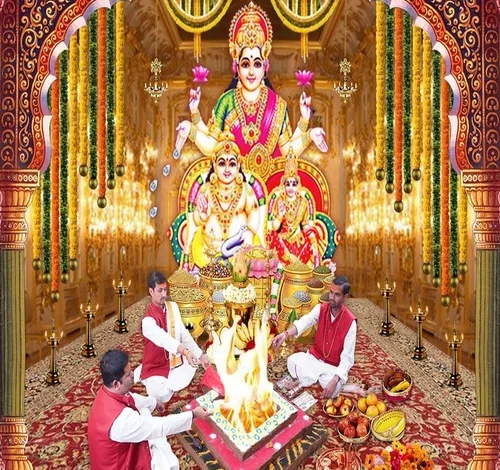Diwali Puja: Significance, Rituals, and How to Perform It
Diwali Puja: Significance, Rituals

Diwali Puja, also known as the Festival of Lights, is one of the most celebrated festivals in India. It symbolizes the victory of light over darkness, good over evil, and knowledge over ignorance. At the heart of the Diwali celebration is the Diwali Puja, a sacred ritual performed to honour Goddess Lakshmi, the deity of wealth and prosperity, and Lord Ganesha, the remover of obstacles. Performing the puja correctly is believed to bring happiness, success, and prosperity into one’s home.
In this comprehensive guide, we will explore the importance of Diwali Puja, the materials needed, and a step-by-step guide on how to perform it.
The Significance of Diwali Puja
Diwali is more than just lighting diyas and bursting crackers. It is a time for family and spiritual reflection. The Diwali Puja holds immense religious significance. This ritual, usually performed in the evening, is dedicated to welcoming Goddess Lakshmi into our homes and businesses. It is believed that during Diwali, the goddess roams the earth, blessing households that are clean, well-lit, and spiritually charged with devotion.
By invoking Goddess Lakshmi and Lord Ganesha together, we are asking for wealth, wisdom, and protection from harm. It is believed that Ganesha clears any obstacles on our path to success, while Lakshmi grants material and spiritual prosperity.
Preparing for Diwali Puja: Materials and Setup
Before performing the Diwali Puja, it is important to gather all the necessary materials and prepare the space for the ritual. Below is a list of items commonly used in the puja:
Essential Materials for Diwali Puja:
Idols or pictures of Goddess Lakshmi and Lord Ganesha
Clay or silver oil lamps (diyas) and ghee or oil to light them
Rangoli designs or decorations at the entrance of the house
Flowers (preferably marigold or rose petals)
Fresh fruit as offerings (like bananas, apples, or oranges)
Sweets (such as ladoos, barfi, or kheer) to offer to the deities
Kumkum (vermilion powder), turmeric, and sandalwood paste for tilak
Rice grains for marking auspicious symbols
Incense sticks and camphor for the aarti
Gold or silver coins, if available
Kalash (a copper or silver vessel) filled with water, betel leaves, and a coconut
Panchamrit (a mixture of milk, curd, honey, sugar, and ghee)
Aarti thali (a plate for conducting the aarti)
The space where the puja is to be performed should be clean and well-lit. It is customary to create a rangoli at the entrance and decorate the puja area with flowers and diyas. Many families also place gold and silver coins next to the idols to invite wealth into their lives.
How to Perform the Diwali Puja: Step-by-Step Guide
1. Clean the House and Set Up the Puja Altar
On the day of Diwali, homes are thoroughly cleaned, symbolizing the removal of negativity. The puja area is then set up with the idols of Lakshmi and Ganesha placed on a raised platform covered with a red or yellow cloth. A small rangoli or kolam is drawn in front of the deities, symbolizing auspiciousness.
2. Lighting the Diyas
Before beginning the puja, light the clay diyas with ghee or oil and place them around the house, particularly near the entrance, windows, and the puja area. The lamps are symbolic of dispelling darkness and welcoming the divine presence into the home.
3. Offerings to Lord Ganesha
The puja traditionally begins by worshipping Lord Ganesha, the remover of obstacles. Begin with the Ganesh aarti, offering him flowers, fruits, and sweets. Apply a tilak of kumkum and rice grains on his forehead. It is said that invoking Ganesha first helps in removing any hindrances during the puja.
4. Lakshmi Puja
After Ganesha is worshipped, attention turns to Goddess Lakshmi, the deity of wealth. The Lakshmi Puja is done with great reverence, as it is believed to ensure prosperity for the upcoming year. Offer panchamrit, flowers, rice, sweets, and coins to her, followed by chanting mantras and performing her aarti. The recitation of the Lakshmi Ashtotram or Lakshmi Chalisa is also an integral part of the puja.
5. Worship of Kuber
Alongside Lakshmi and Ganesha, Lord Kuber, the god of wealth, is also worshipped during Diwali Puja. Offering prayers to Kuber ensures financial stability and security. A lamp, fruits, and coins can be offered to his image or symbol as part of this ritual.
6. Conducting the Aarti
After the offerings, the aarti is performed for both deities. The aarti thali, filled with lit diyas, flowers, incense, and camphor, is rotated in front of the deities while chanting the Lakshmi aarti and Ganesha aarti. Family members can join in this final step of the puja, clapping their hands in rhythm.
7. Concluding the Puja
Once the aarti is complete, seek blessings from the deities by bowing down before the idols and placing your hands over the flames of the diyas, drawing warmth and light towards you. Distribute the prasad (sweets) among the family members and neighbours as a token of divine blessings. It is also customary to give gifts to family members during this time.
Why Perform Diwali Puja?
The Diwali Puja is not just a ritual but a way of inviting peace, prosperity, and harmony into your life. It is a time to reflect on the triumph of light over darkness and to seek blessings for the future. When done with faith and devotion, the puja is believed to bring positive energy into one’s home, remove financial troubles, and strengthen family bonds.
Conclusion
The Diwali Puja is an essential part of the Diwali celebrations, symbolizing hope, prosperity, and spiritual upliftment. Performing the puja with devotion and the correct rituals ensures that we invite divine blessings into our homes, leading to success and happiness in the coming year.





